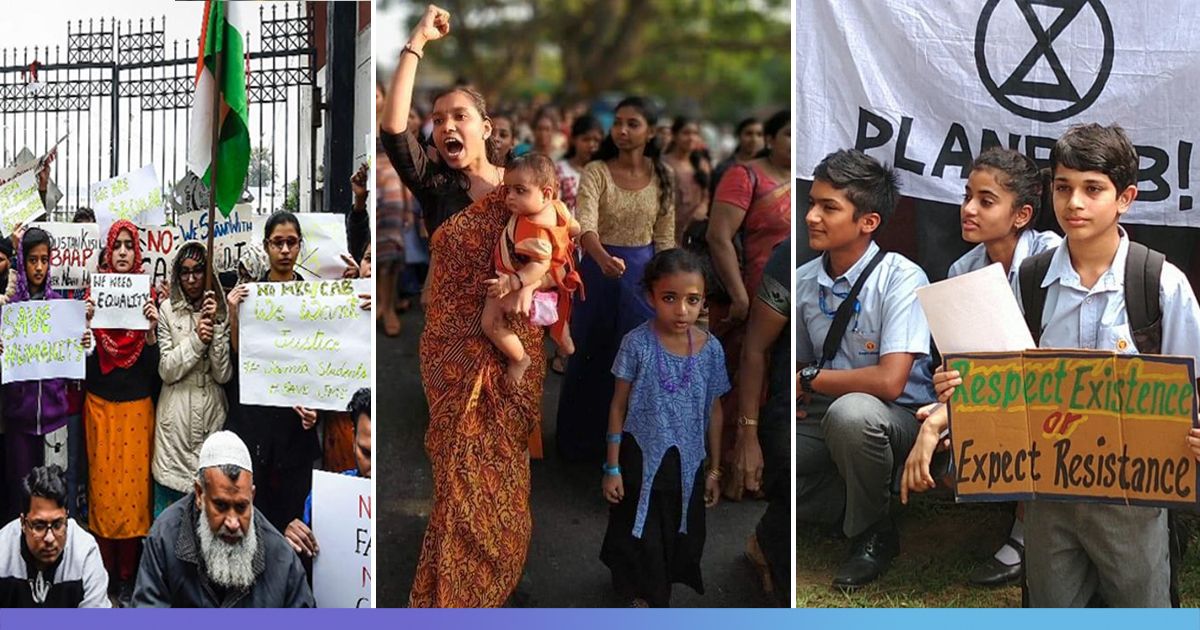
From Save Aarey Forest To Anti-CAA Protests: Six Times When Indians Took To Streets In 2019
1 Jan 2020 4:38 AM GMT
Editor : Reethu Ravi
Reethu, a story teller, a person often found between the pages of a book or contemplating the nuances of life.
From women forming a 620 kilometre-long ‘women’s wall’ to uphold gender equality in Kerala to citizens across the country coming out in large numbers to protest against the new Citizenship Act, 2019 saw massive mobilisation of people to stand behind a cause.
Irrespective of gender, religion, and age, people from all walks of life thronged the streets. While some fought for their rights, some fought for the environment. And Some others fought to uphold the values of the Constitution.
Here is a look at the major social movements that shook the country.
January: Kerala Women Form ‘Women’s Wall’
In what can be deemed as the largest gathering of women Kerala has witnessed. Around 30 lakh women stood shoulder to shoulder along national highways to form a 620-km long ‘Vanitha Mathil’ or ‘women’s wall.’
On new year’s day, the women lined up in the state to uphold Kerala’s renaissance and gender equality. Led by the CPI(M)-led LDF government, the ‘wall’ stretched from the northern tip of Kasaragod to the southern end in Thiruvananthapuram. While Kerala Health Minister KK Shailaja led the chain, it ended with CPI(M) leader Brinda Karat.
The initiative of the government, backed by several political, religious and social groups had come in the wake of widespread protests against the September 2018 Supreme Court verdict allowing entry of women of all ages to Sabarimala temple.
From social activists, film stars, and theatre personalities to writers, farmers, and sportspersons, the event saw the participation of women from all walks of life.
CM Pinarayi Vijayan warmly congratulates all who made Kerala's #WomensWall a great success. The 620 KM long gathering, organized to uphold the values of Kerala Renaissance, saw huge participation of women from all walks of life. This is a momentous occasion in our social life. pic.twitter.com/DiJlgzgSUO
— CMO Kerala (@CMOKerala) January 1, 2019
June: Doctors Protest Against Assaults
In an attempt to bring an end to the atrocities against medical practitioners, doctors across the country went on a week-long strike after two junior doctors faced assault in West Bengal.
Pratibha Mukhopadhyay and Yash Tekwani, intern doctors of Nil Ratan Sircar (NRS) Medical College and Hospital in Kolkata were brutally beaten up by the family of a deceased patient citing medical negligence on June 10.
Kolkata:Junior doctors at NRS Medical College&Hospital go on strike after doctors were allegedly attacked by a patient's family who died yesterday.Chandrima Bhattacharya,Health Min,says,"Emergency is open&talks are on.4 ppl have been arrested in connection with attack on doctors" pic.twitter.com/EU3HNJvfnV
— ANI (@ANI) June 11, 2019
The incident triggered statewide doctors’ strike demanding security at government hospitals. When Chief Minister Mamata Banerjee visited the state-run SSKM Hospital to talk to the protesting doctors on June 14, her comments only added fuel to the fire.
She not only lashed out at the junior doctors for staging the protest but called the strike a “BJP conspiracy.” She also served an ultimatum to the protesting doctors saying that the government will take actions if they refuse to end the agitation, but the doctors continued their protest.
Soon, the doctors’ fraternity across the country went on a strike wearing helmets and forming human chains in solidarity with the protesting doctors in Bengal, sending healthcare services in the country to a state of turmoil. Out-Patient Departments(OPD) remained closed and scheduled surgeries were postponed in many governments and private hospitals across the country. A number of doctors also resigned from service in protest.
The doctors called off the strike only after Banerjee agreed to their demands during a meeting at Nabanna on June 17.
September: India Joins Global Climate Strike
In a year that the world woke up to climate emergency, Indians across the country took part in demonstrations in support of the Global Climate Strike from September 20 to 27.
The strike was held in parallel to the Fridays for Future movement – a movement started by teenage climate activist Greta Thunberg in August 2018 against inaction towards climate change.
The strike that spread across the lengths and breadths of the country saw students walking out from classrooms and adults stepping out of their workplaces and homes.
School students in Patna have taken to the streets today to demand government action on #climatechange.
Join the #climatestrike in your city and support them. #GlobalClimateStrikes #FridaysForFuture #ActOnClimate #WhyOnEarth #Strike4Climate pic.twitter.com/IxdPbtEth2
— WhyOnEarth (@WhyOnEarthYKA) September 27, 2019
While the country witnessed climate strikes throughout the year, the September strike came in the wake of the United Nations Climate Action Summit 2019 that took place in New York on September 23.
School students in Delhi have taken to the streets today to demand government action on #climatechange.
Join the #climatestrike in your city and support their initiative. #GlobalClimateStrikes #FridaysForFuture #ActOnClimate #WhyOnEarth #Strike4Climate @WhyOnEarthYKA pic.twitter.com/bZYqmR8IUW
— Youth Ki Awaaz (@YouthKiAwaaz) September 20, 2019
October: Save Aarey Forest Movement
At a time when governments across the world are making efforts to combat climate change, Bombay High Court rejected petitions and cleared the way for felling 2,646 trees in the 1,300-hectare forested expanse of Aarey colony in the city on October 4. The land was for the construction of a car shed as part of the Metro Rail Project.
The city authorities and Mumbai Metro Rail Corporation Limited (MMRCL) had announced the plan to clear 30 hectares of the colony in 2015. After multiple legal challenges, the Mumbai Municipal Corporation’s Tree Authority Committee approved the proposal to cut nearly 2,700 trees in Aarey colony.
The “Save Aarey” protest rallies that had been going on since the car shed was first proposed gained momentum after the approval in August. Thousands of protesters took to the streets on September 1 with placards and posters and formed a human chain near the proposed car shed to show their dissent against the move. It was amidst the continued protests across the city that HC cleared the way to fell trees.
Within hours of the HC order, Mumbai Metro Rail Corporation Limited (MMRCL) cut hundreds of trees in the Aarey Colony through the night of October 4 and into October 5. As it came to the notice of citizens and activists, hundreds of protesters poured into Aarey to save the ‘green lungs of Mumbai.’
In the morning, police arrested 29 protesters and detained around 200 others, including NCP leader and MLA Jitendra Awhad.
The protests also saw the support of Bollywood actors including Manoj Bajpayee and Diz Mirza and members of various political parties including Shiv Sena Corporator Sheetal Mhatre and party leader Priyanka Chaturvedi.
400 trees have been cut in the dead of the night. As citizens sang and joined hands in unity pleading to STOP this massacre. Can’t you see they are UNITED by love!?! Love for nature. Love for our children and our future. #Aarey #ClimateAction #ActNow #ChangeIsComing pic.twitter.com/7XCwSeaqDT
— Dia Mirza (@deespeak) October 5, 2019
As the protests gained momentum, police were deployed in large numbers and Section 144, banning the assembly of more than four people, was also imposed in the city till the morning of October 6.
On October 7, the apex court then ordered that no more trees should be cut in the area. However, the Supreme Court on October 21, 2019, refused to stop the Metro shed project work.
Meanwhile, on November 29, newly elected CM Uddhav Thackeray ordered to stop the construction work of the shed, much to the relief of activists and Mumbaikars.
November: JNU Students Protest Fee Hike
Jawaharlal Nehru University(JNU) once again witnessed massive protests when hundreds of students took to the streets to protest against a proposed 300 per cent increase in hostel fees on November 11.
The protests came in the wake of a draft of a hostel manual which was circulated on October 4, came to the notice of the students. The government’s draft proposed a hostel fee hike from ₹20, for a single room per month to ₹600 and for a shared room, the fees increased from ₹10 to ₹300. Maintenance service fee and hostel mess deposit were also increased and an additional service charge was also introduced.
Why did #DelhiPolice lathi charge students who were peacefully protesting the #JNUFeeHike? They are exercising their democratic right to peaceful protest. Legit ‘coz 43% students will be unable to finish their degrees if the hike is implemented!!!! Pics: Noushad & Sarika pic.twitter.com/V0oCkU9R34
— Swara Bhasker (@ReallySwara) November 19, 2019
The protests escalated on November 11, when students clashed with the police outside the All India Council of Technical Education (AICTE) premises. The police lathi-charged and used water cannons on the students and also detained several students. The protesters also broke barricades and gheraoed the place.
Following the agitation, on November 13, JNU Administration announced a partial rollback of the hostel fees. But the students rejected the proposal, and dubbed it as an “eyewash.”
A week later, the students further took out a march from the JNU campus to Parliament but were stopped and lathi-charged by police at multiple locations.
As the protests continued and several students boycotted exams, JNU administration issued a warning to students who have boycotted examinations that they will not be allowed to register in the next semester if they do not fulfil the institute’s academic requirements.
Despite the continuing protests by the students, JNU on December 30 said that it will implement the new hostel manual from January 1. The university Vice-Chancellor also appealed to the students to call off their strike. A circular was also issued asking students to register for the new semester between January 1 and 5.
December: India Protests Against CAA, NRC
In one of the largest mass movements the country has witnessed in the recent times, students, activists, political leaders, took to streets in huge numbers against the contentious Citizenship Amendment Act and proposed National Register of Citizens(NRC).
The protests took a violent turn after clashes erupted between Jamia Millia Islamia (JMI) students and the police on December 15. In solidarity with the Jamia students, student fraternity across the country erupted in protests against CAA, NRC and police brutality.
D. Raja, Sitaram Yechury among other manhandled and detained by Delhi Police from Mandi House. #CAAProtest https://t.co/kNFKbwC4Q9 pic.twitter.com/ZVlCHP58VU
— Girish (@GirishNaught) December 19, 2019
In various parts of the country, protesters clashed with police who lathi-charged, used water cannons and tear gas shells. Several protesters were also seen pelting stones at the police. As protests turned violent, the internet was shut down, and section 144 was imposed in various parts of the country, sending the nation into turmoil.
So far, 25 people have lost their lives amidst the widespread protests across the country.
In Assam, on December 12, five people, including a 17-year-old lost their lives after police reportedly opened fire on protesters.
During the anti-CAA protests in Mangalore on December 19, two people succumbed to bullet injuries.
In Uttar Pradesh alone, 18 people died, 288 policemen were injured and 1,113 people have been arrested across the state since December 19. Undeterred, protests across the country still continue.
Also Read: UP: FIR Against SHO, 5 Other Cops In Bijnor, For 20-Yr-Old’s Death During Anti-CAA Protests
 All section
All section













